In Claudia and the New Girl, book twelve of the Baby-Sitters Club, one of the trademark traits of the BSC begins to fully emerge; The Clique.
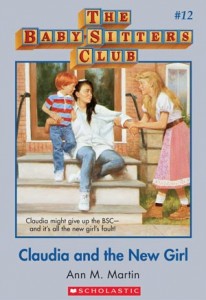 The Baby-Sitters Club has been in full operation for a year now. The girls are becoming closer, better friends thanks to their adventures and mutual love of pizza parties. They’re even spending lunch times together now, Claudia mentions, when explaining how close the club has grown and how important they are to each other.
The Baby-Sitters Club has been in full operation for a year now. The girls are becoming closer, better friends thanks to their adventures and mutual love of pizza parties. They’re even spending lunch times together now, Claudia mentions, when explaining how close the club has grown and how important they are to each other.
True friendship is sitting with someone in the cafeteria, and though it’s never explicitly said like that, it’s a “truth” we’re reminded of in many ways, even in the closing pages of the book.
So when Claudia Kishi starts spending a bit of time with a new girl, Ashley Wyeth, the other BSC members as a whole take cattiness lessons from Mary Anne’s previous fine examples, and react as you’d expect; by eating all of Claudia’s stashed junk food, short-sheeting her bed and leaving venomous notes hidden around her room for her to stumble upon long after they’ve left.
But of course, that the BSC resorts to these petty attacks is Claudia’s fault. If she had made it to the tri-weekly Baby-Sitters Club meetings, in her own room, they wouldn’t have had to do all this stuff to their traitorous vice-president.
Boy, they sure show her. Dawn – cool, casual Dawn, of all people – even comes up with a chant while riding over to Claudia’s house one day, where she’s taking on the role of vice-president in Claudia’s absence:
“Traitor, traitor.
Claudia – we hate ‘er!
Traitor, traitor.
So long, see you later!
Good-bye, Claudia.”
The notes they leave stashed around Claudia’s room are pretty amazing, too. Stacey is the instigator of the hidden note scheme, feeling more betrayed by Claudia than any of the others, since Claudia is meant to be her best friend.

Actual note Stacey leaves under Claudia’s pillow. Even in anger, Stacey manages to be poetic; perhaps she SHOULD write that “Taming of the Shrew” retelling she mentioned in the last book?
There are moments that you do feel sorry for Stacey – where she starts crying because she thinks Claudia doesn’t like her any more. But after Claudia says she can’t go to the mall with Stacey because she’s studying, but is then later on seen wandering around with Ashley, the McGill girl goes on the war path, and naturally Kristy, Mary Anne and Dawn are all (a little too) eager to join her.
Stacey had said, “Hey Dawn, let’s hide some notes for Claudia to find.”
“Notes? What kind of notes?”
“Mean ones.”
Stacey hides poems under her pillow (as well as the above breadbox classic, she also comes up with a slightly less sophisticated “Roses are red, violets are blue, traitors are jerks and so are you.”), Dawn hides her “Traitor traitor” chant note in Claudia’s jewellery box, and Kristy, after she and Mary Anne finish short sheeting Claudia’s bed, leaves a blank note under Lennie, Claudia’s rag doll.
“What for?” asked Stacey.
“To drive her crazy. She’ll wonder if we used invisible ink, or maybe wrote something so mean we had to erase it.”
Claudia finds the notes, the empty junk food packets, and the short-sheeted bed, and does nothing about it, being too tired and overwhelmed by the amount of work she’s trying to squeeze into her life.
Not only is Claudia negotiating retaking the majority of her tests and reading both The 21 Balloons and A Wrinkle in Time for English class, baby-sitting the Rodowsky boys (they’re pretty much the only client she has jobs with in the book), school and art classes, she’s being dragged here and there by Ashley, who has become her sort of artistic guide. Something’s gotta give, and that something ends up being a lot of BSC meetings.
Ashley is a fabulous artist. Art is her life. She moved from Chicago, where she went to Keyes Art Society, an art college that Claudia raves and gapes about, which Ashley says Claudia would be good enough to go to.
Claudia describes what Ashley is wearing, all the time, from the moment we meet her:
Sounds like Kat Stratford out of 10 Things I Hate About You, amirite?
Well, this girl, Ashford or whatever her name was, looked like a hippie. She was wearing a very pretty pink flowered skirt that was full and so long it touched the tops of her shoes – which I soon realized were not shoes, but sort of hiking boots. Her blouse, loose and lacy, was embroidered with pink flowers, and both her wrists were loaded with silver bangle bracelets. Her hair, which was almost as long as my friend Dawn’s and was dirty blonde, was pulled into a fat braid (which, I might add, was not held in place with a rubber band or anything; it just sort of trailed to an end). But the amazing thing was that because her hair was pulled back, you could see her ears. And she had three pierced earrings in each ear. They were all silver and all dangly, but none matched.
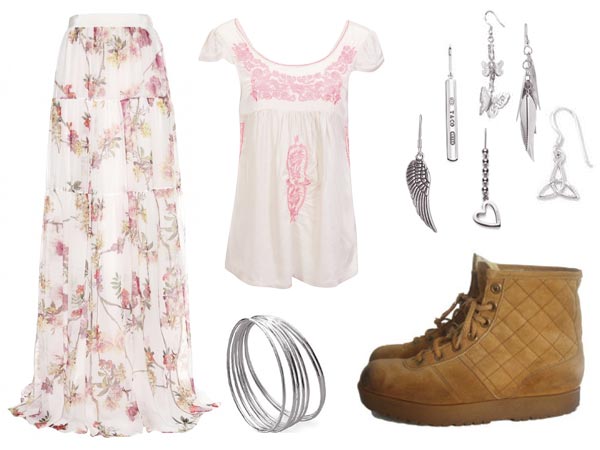
She [Ashley] was wearing a puffy white blouse, a blue-jean jacket, a long blue-jean skirt, and those hiking boots again. Beaded bracelets circled both wrists, and she’d tied a strip of faded denim around her head, like an Indian headband.
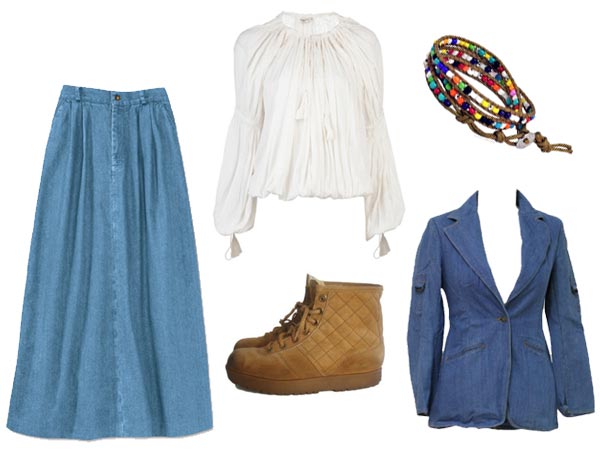
Of significant interest are Ashley’s earrings – which vary greatly owing to her quirky style and 6 piercings:
Two golf balls and a hoop in one ear. A seashell, a real feather and a dangly flamingo in the other. Pretty cool.

As the book progresses, and Claudia starts to grow frustrated with Ashley’s clingy-ness, the outfit descriptions start to become a little more detrimental:
She [Ashley] was wearing a long, all-the-way-to-her-ankles dress with three rows of ruffles at the bottom. A strip of black cloth was tied around her head. I couldn’t see her earrings, but she looked…well, all right, I’ll admit it. She looked a little bizarre.
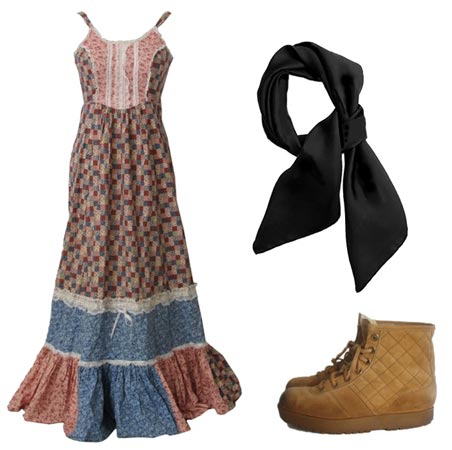
Ashley looked just plain weird in her outfit – a long knitted vest over an even longer shirt which we was wearing tails-out over a skirt that didn’t match either the vest or the shirt. And there were those hiking boots again.
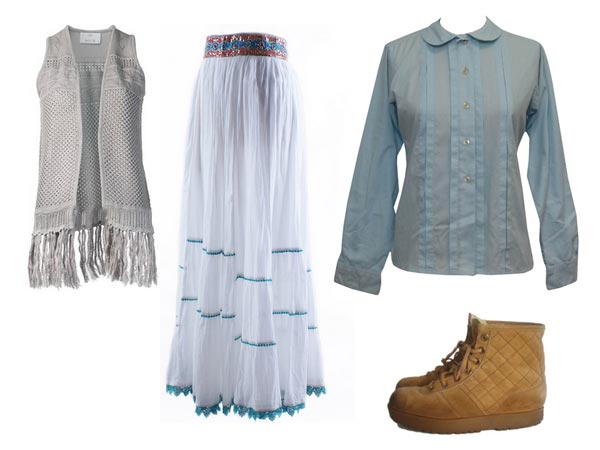
I don’t get how Claudia, of all people, could judge somebody’s outfit as being “too weird”. She only describes one of her own outfits in the whole book, unfortunately, and I fail to see how a maxi dress and black headband can be called “a little bizarre”, when her own array of outfits and seemingly unrelated accessories are perfectly acceptable:
I was wearing a very short pink cotton dress, white tights, and black ballet slippers. I had swept all of my hair way over to one side, where it was held in place with a piece of pink cloth that matched the dress. Only one ear showed, and in it I had put my big palm tree earring.
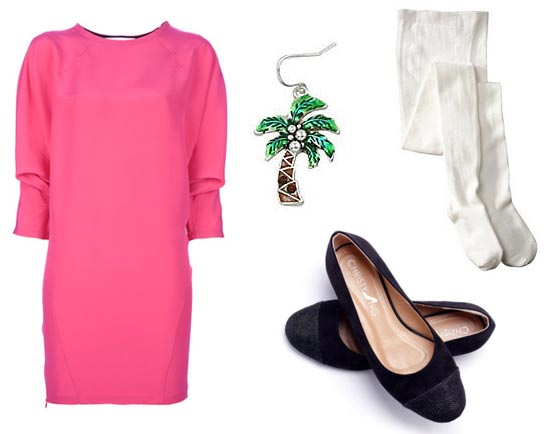
From the moment Claudia sees Ashley, she is desperate to befriend the new girl. She’s fascinated by her appearance, and makes a lot of effort to engage her in conversation. Ashley, on the other hand, is initially hesitant to form a relationship with Claudia.
Then Ashley said quietly, “Um, hi. Do you know where room two-sixteen is?” It sounded as if it were killing her to have to talk to me. She certainly wasn’t the friendliest person I’d ever met.
Claudia does the right thing to gain Ashley’s attention, though, and engages her in a conversation about art – specifically, sculpting.
It’s not long before Ashley is clinging to Claudia, convincing her to sit with her (and only her) at lunchtimes, trying to convince her that her art is more important than anything else in her life, and that she should spend every spare moment working on her craft.
While Claudia does continually tell Ashley that baby-sitting is very important to her, and she loves it, she also enjoys Ashley’s encouragement. It’s not often, Claudia says, that anybody gives her praise – well, anybody who actually knows anything about art, that is.
Ashley becomes Claudia’s self-appointed mentor —
“I am an artist and my craft is calling,” said Ashley earnestly.
“Calling what?” I replied.
“Calling me. Like the call of the wild.”
…It’s pretty pathetic to be one of the persons in a two-person conversation and not following the drift of things at all.
— and convinces Claudia to enter a sculpture contest with her that’s taking place in two weeks time, to mark the opening of a new gallery in town. They have a load of arty, supposedly inspirational conversations and walks throughout town, searching for the subjects of their sculptures, since Ashley has convinced Claudia that they should both do something contrary, and sculpt inanimate objects.
“You want us to sculpt dead things?” I asked in horror. I was imagining ghouls and corpses and mummies.
During their first walk through town, where the exclaim over the hidden potential and form of gum wrappers and discarded dish rags, Ashley decides that she is going to sculpt a fire hydrant.
“Look at the way it’s shaped. It’s…almost noble. It’s little and squat, but it’s sitting up straight and square, like a jockey on a prizewinning steed.”
And then even Claudia manages to get arty-farty about a traffic light:
“Think of the power it holds. It controls the traffic. It can make people late. It can prevent accidents. It’s a little box doing an awfully big job.”
It is during this inspiring walk of squashed soda cans and other dead inanimate things that Claudia realises she’s going to be late for another Baby-Sitters Club meeting, and hurriedly calls Dawn to cover for her.
Ashley doesn’t understand Claudia’s worry over the meeting at all, and when Claudia tries to explain (again) that the Club is important to her, and the other members are her friends and she’s letting them down, Ashley pulls a guilt trip of her own; “But…I’m your friend, too, am I not?”
Claudia can’t help but feel bad for Ashley. She is her only friend. Maybe, Claudia thinks, I’m really important to her, too.
Ashley Wyeth is a piece of work, though. During the book I simultaneously felt sorry for her and wanted to throw things at her. The girl was painted as shy, alternative, introverted and creative, but at the same time, manipulative, pretentious and when it came down to it, totally ice cold.
Ashley, it turns out, doesn’t want to be friends with Claudia. Ashley wants to be friends with art.
The Baby-Sitters Club, after their “let’s trash Claudia’s room!” moment, figure this out.
“…You know, I think all Ashley really cares about is art, and she’s found a good artist in Claudia. Maybe Claudia is sort of a project for Ashley.” Mary Anne paused, putting her hands in her lap and staring down at them. “Oh, I’m not explaining myself very well.”
“You’re explaining yourself fine,” said Stacey. “What you just said is that Ashley likes Claud because she’s an artist, not because she’s Claud. And if that’s true, I’m beginning to wonder just how good a friend Ashley Wyeth is.”
Is it worth noting that, even after realising that Ashley is using Claudia, the BSC don’t undo the damage or remove the notes in her room? Nah.
Lucky for our Claud, she begins to realise the same thing on her own. While she’s sitting for the Rodowsky clan one afternoon, who happen to be Ashley’s neighbours, Ashley comes over and – in front of the three little redheads, asks Claudia (again) why she’s wasting her time on … “all this”.
I paused. “All what?” I finally said, somewhat testily.
“This uselessness.”
“They’re children,” I replied quietly. “They’re important to me.”
“Oh, you sound so sentimental,” Ashley scoffed, looking at the ground.
The fight escalates, as Claudia tries to explain that there’s nothing wrong with an artist being sentimental, until both girls finally explode.
Ashley’s ice-blue eyes turned icier. “This is the thanks I get for–”
“For what, Ashley? What did you do that you expect thanks for? What did you do that you wouldn’t have done just because you’re my friend?”
“I taught you about sculpting. I taught you how to look beyond Ms. Baehr and see what else you can do.”
“And you think you deserve to be paid back? You think I owe you something? Friendship doesn’t work that way. Friends are friends because they like each other, not because they’re in debt.”
It is after the fight that Claudia decides what she’s going to sculpt; not a powerful traffic light, but a bust of Jackie Rodowsky, Stoneybrook’s epic, adorable, red-headed klutz. Jackie is thrilled that he’s going to be in a show, and Claudia spends a few more afternoons at the Rodowsky’s to sketch the wild child.
At one of the sketch-a-thons, Mary Anne happens to be baby-sitting, and gets to witness another Ashley hissy-fit.
Ashley leaned over to look at the sketch I was working on. “I saw your bike outside. What are you doing here? I couldn’t believe you were babysitting again…and I see you aren’t.”
“Nope. I’m starting my sculpture for the show. That should make you happy.”
“Not if you’re going to sculpt him,” replied Ashley, pointing.
Jackie’s eager face fell.
“Him has a name,” I told her. “He’s Jackie. And he’s one of my good friends.”
Jackie’s smile returned cautiously.
“So, you lost your nerve,” Ashley went on, as if she hadn’t heard me. “You’re going to sculpt a person.”
Her parting words, this fight, are “You’re ruining your career, you know”, as she lets herself out of the Rodowsky’s house.
Claudia tries to dismiss all this chaos going on around her “friends” so that she can focus on the mountain of schoolwork and art projects she has to climb, but continually finds (old) nasty notes in her room, and continually feels like she’s been a jerk to Ashley, Stacey, and the whole BSC.
Through the power of lists (she writes several), Claudia starts repairing everything. She drops out of the sculpture competition (though still intends to finish the Jackie Rodowsky sculpture, just at a pace she’s happier with), repairs things with Stacey, catches up on her school reading and starts attending BSC meetings again.
Claudia even gets an award at the sculpture competition – which her teacher, Ms. Baehr, entered her Jackie piece into as a ‘work in progress’ (as someone once remotely connected to visual arts, I would have been mortified if a teacher had submitted a work in progress of mine into an art show. The nerve!). Ashley, of course, wins the competition, with her beautifully sculpted fire hydrant, which she somehow manages to make come to life, as an ‘animated inanimate object’.
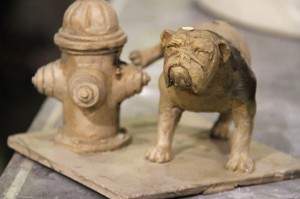
And I really hope it looked like this.
By the end of the book, Claudia’s trying to be kind to Ashley, despite how the girl treated her, by inviting her to sit with the BSC at lunchtime. She knows that there’ll always be a boundary between them, of Ashley’s own making.
After that day, Ashley sometimes sat with us but often sat alone. Either way, it was okay. She and I had become sometimes friends, and that was okay, too.
Not according to your lord and master, Kristy Thomas, dear. I have to wonder if Ashley Wyeth ever shows up in the Baby-Sitters Club books again. I’ll look out for her.
There’s a couple of brand names mentioned in the book that I feel compelled to identify; firstly, junk food:
“Looking for Claudia’s Bazooka bubblegum. I know she’s got some stashed somewhere.”

Secondly, something that the school lunch smells like…
Kristy was saying, “You know the smell of sneakers after gym class? And you know the smell of Cuthbert Athlete’s Foot Creme? Well, if you mixed those smells together, wouldn’t they smell just like this pot roast?”
Cuthbert Athlete’s Foot Creme that smells sort of like a pot roast? Unsurprisingly, I can’t find it on Google.
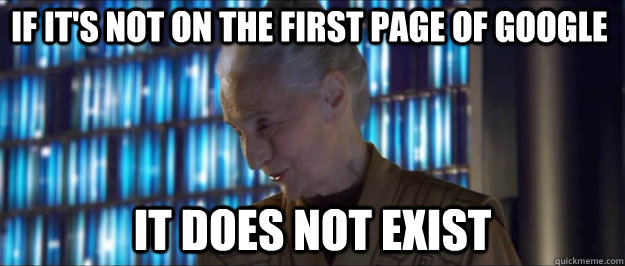
And lastly, a poster of Max Morrison, stuck with chewing gum to the inside of Claudia’s locker. Max Morrison is, apparently, the most gorgeous star in the history of television, and, according to the mention of him in Logan Likes Mary Anne!, is from a TV Show called Out of This World.
http://www.youtube.com/watch?v=TfOh_0r8V0M
OH MY GOD, this show looks incredible (in an 80’s sitcom kinda way XD) – kudos to Ann M Martin for mentioning it!
Before I get carried away with tracking down episodes of Out of This World, I’d better sum up. So, the message of this book? Something about friendship. Or something about loyalty.
I can’t be sure, considering how the super-best-friend club react to Claudia being swept away by artistic Ashley. They felt betrayed, sure, but they completely lost their shit, and if Claudia had reacted by kicking the BSC out of her room forever, I wouldn’t have minded.
Perhaps the moral of the story ties into all the baby-sitting jobs at the Rodowsky’s, and is that friendship is complicated and hard work and full of accidents. That friends like you for you, despite your differences and any mishaps along the way are forgiven because…ugh. I sound like an after-school special.
The real lesson you can take from this book isn’t really so wishy-washy and is simply this; never, EVER, piss off the Baby-Sitters Club.
Next book in the series is Good-bye Stacey, Good-bye – oh no! Already? I remember that Stacey moves back to New York (for a while), but didn’t realise that it would be so soon! Cripes, if the BSC felt betrayed by Claudia spending time with another girl in the same town, how are they going to react when one of their members leaves (whether she has any choice in the matter or not)?!
Run, Stacey. RUN FAST.
Want to read about the BSC’s attack on Claudia’s bedroom for yourself, or take the magical mystery tour of Stoneybrooke’s inanimate objects? Claudia and the New Girl is available for Kindle on Amazon for about $5.

Fire hydrant pic interpretation just made my day 😀
Apparently it’s a famous sculpture in – of all places – Chicago. I have to wonder (read: hope) if the artist went to Keyes (…which I don’t think exists?). And was mentored by Ashley.
http://chicago-outdoor-sculptures.blogspot.com.au/2011/02/making-of-bulldog-and-hydrant-part-iv.html
I…I am getting such mixed messages from this storyline. I thought the BSC was supposed to be a symbol of everlasting friendship, loyalty, and support, a safe space for teenage girls to grow into mature young women capable of minding small children. But THIS? ‘Say hello to your friends’, my butt.
I don’t know, maybe the whole fiasco is meant to represent a reality rather than an ideal. 13-year-old girls can be awfully catty–sometimes even more to their friends than their enemies. So perhaps I should admire a story that shows how dark adolescent loyalties can be. But CRIPES. Hate chants and hidden notes? Really? I’m with you: never piss off the BSC.
If I recall, Stacey leaving is the opening for Jessie to enter, since…er, I’ll avoid spoilers. But look forward to Mallory and Jessie becoming Junior Members in the near future! 😛
Fifi I was so shocked as well. The BSC treat Claudia absolutely appallingly – and Ashley as well. There was a moment I was considering quoting (but figured I may as well leave it out since the point had been made) where Claudia and Ashley are talking at Claudia’s locker, and the whole BSC come over, snippily say “Hi Claudia” each, and then STACEY – who has generally been such a kind kid, particularly to new people, looks Ashley up and down and says “nice dress” with disdain.
I had to wonder what would have happened if Ashley hadn’t turned out to be such a psycho. Would Claudia have kicked the BSC out of her room, and quit? She would have had every right to. I wonder if AMM turned Ashley into the demanding, tactless character that she did, simply so she could validate the BSC’s treatment – “we never liked Ashley because she didn’t like Claudia for Claudia anyway, so we were only…” – only what? Victimising her for her own good (it does sound like something Kristy would say)?
Written from Claudia’s perspective, while she’s miffed and frustrated by their reactions, she still ends up feeling guilty that she’s letting them down the whole book. She sort of sighs when she finds one of the notes, thinking that it’s all her fault. So what’s the message there? Don’t try to do too much, or something will have to be let go? Don’t forget your friends when someone new and shiny comes along – or you deserve the consequences? Do thirteen year olds (or younger, considering the target audience) really need these messages (I can’t even remember if I did)?
I’m looking forward to the junior officers starting up with the BSC too, because I remember so little about them! And Mallory so far as simply been a Pike kid whose character exists to help the BSC sit for her family and occasionally do math homework. I think after Good bye Stacey, Good bye we have our first Mal book!
Exactly how I would’ve phrased it. I mean, those years are a real ruckus… But I was BEYOND shocked by their behaviour. Literally. I was gaping.
I absolutely love the Baby-sitter club.I have been to Keyes. It is amazing.
I also agree with Min. Mal is finally getting a book!